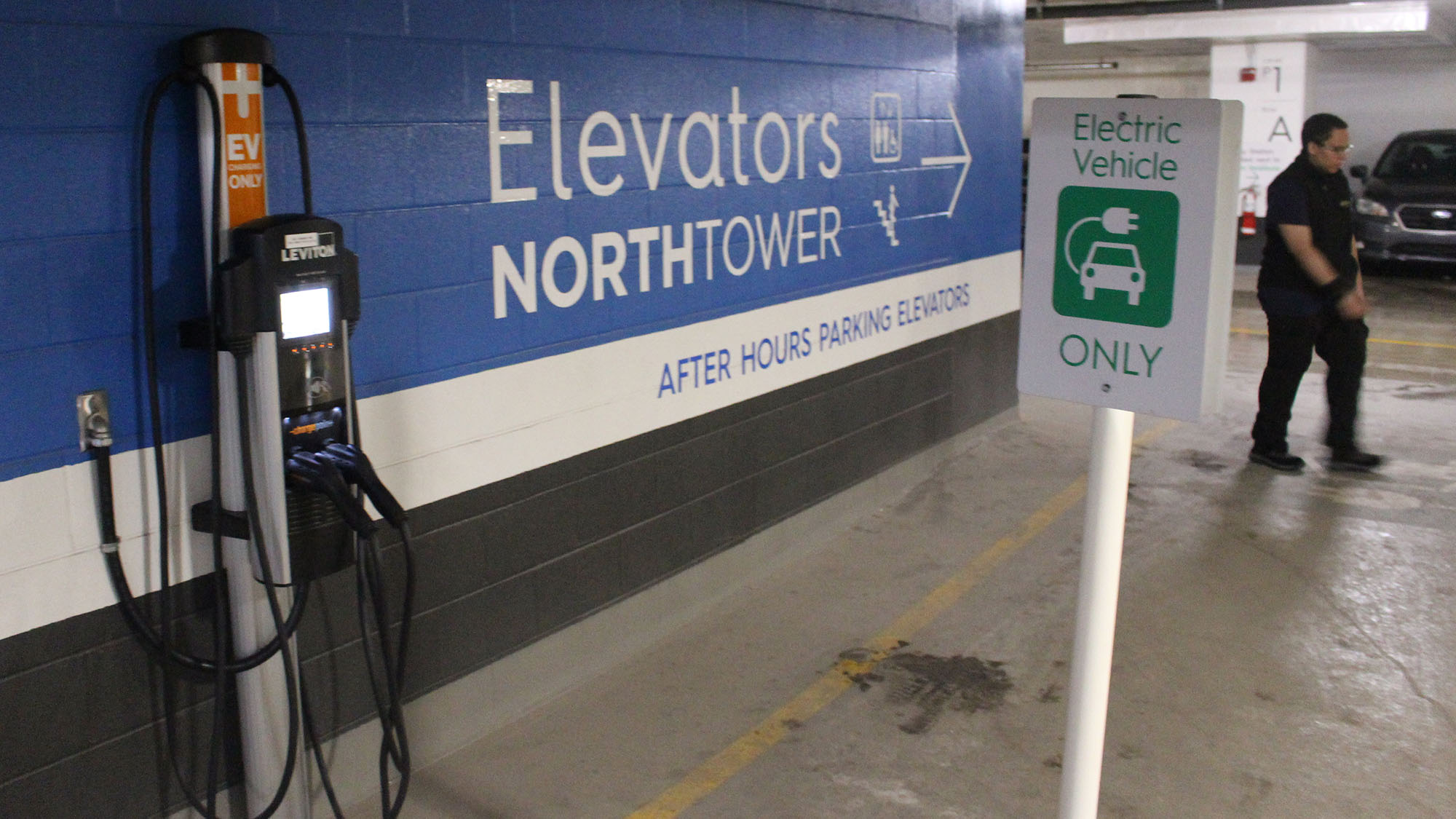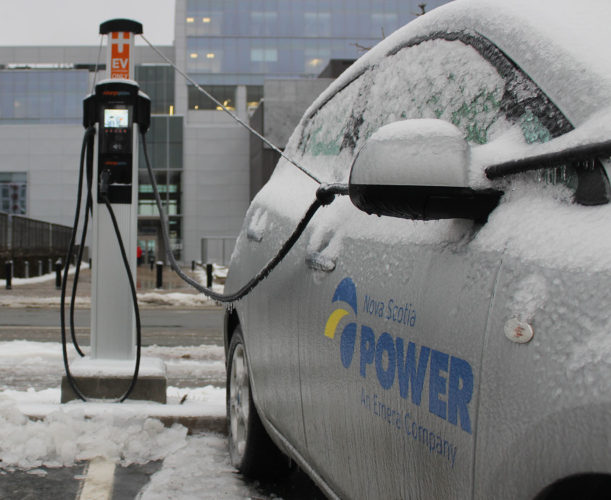Electric vehicle ownership in HRM not easy for people in apartments, condos
NS Power and HRM are looking ahead for ways to develop infrastructure for apartment and condo dwellers to charge electric cars

caption
An electric vehicle charging station in the parking garage of the Halifax Convention Centre. Installing these chargers in old and new buildings in HRM will be key to making driving electric a viable option for more HRM residents.Halifax is looking to find ways to make charging an electric vehicle at home as easy for apartment and condo dwellers as it is for homeowners.
That’s because electric vehicle (EV) use is expected to increase dramatically across Canada in the coming decade and people living in multi-unit residences don’t currently have many options for charging in their buildings.
On Tuesday, Halifax Regional Municipality issued a request for proposal to hire a consultant to develop a municipal strategy that would prepare Halifax for more EVs on the roads. Part of that strategy will be to look at ways to overcome barriers to EV ownership.
One of the biggest barriers for HRM residents living in apartment and condominium buildings is charging at home. Homeowners can buy a charger and hire an electrician to install it and hook it up to their home’s electrical system, but for residents of multi-unit buildings, it’s not so simple.
“EV charging in multi-unit buildings is probably one of the most complex applications for EV charging at this point,” said Sanjeev Pushkarna, Nova Scotia Power’s manager of customer solutions.
In an interview, Pushkarna said each building must be considered on a case by case basis when figuring out how or whether a tenant can install a private charger.
“It depends really on building ownership, existing electrical capacity, parking spot availability, condo board policy. So a lot of different things that you have to consider,” he said.
Homeowners vs. multi-unit residents
Most electric vehicle (EV) owners do the majority of their charging at home, overnight. That way they are guaranteed a charging spot every day and wake up to a full battery every morning. But to charge at home, they need to first install a charger.
Homeowners can buy a charger and pay to have it installed and hooked up to their own electricity. But the process is more complicated for people living in apartments, condos or other multi-unit residences.
Apartment tenants don’t own their building or parking spaces, leaving the decision to install chargers for electric vehicles (EVs) up to the building owner, even if the tenant offers to pay for all the expenses.
Those who live in condos do own their units and parking spaces, but they must have construction done on building property to install charging infrastructure, like the conduits that attach chargers to the building’s electricity. As such, they require the permission of their condo’s board to set up a charging station.
For both apartment and condo tenants, building owners then have to find an affordable way to measure electrical use of chargers so they can bill tenants separately.
Right now, Pushkarna said there is no template for installing chargers in these buildings. Owners and tenants must work out the details amongst themselves. Then electricians must evaluate the best way to install a charger based on the building itself.
Pushkarna listed different ways building owners and tenants are currently setting up chargers in these buildings. Some use sub-metres that measure electrical use of chargers individually, others use smart metres that constantly monitor electrical use of multiple chargers and make it easier for landlords to set up separate bills under one system. Building owners can also set up monthly fees that would allow them to continue charging for infrastructure costs as well as electricity.
“Eventually I’d love if we got to a point where we could have more of a turnkey solution for Nova Scotia multi-residential tenants as well as building owners,” he said. “But we’re not quite there yet. We’re still learning.
Getting chargers into buildings different for each case
Ann Thaw lives in a 25 unit condominium in Halifax’s North End. She said she would like to switch to an electric car, but would have no place to charge it at her building. She said an electrician from Nova Scotia Power evaluated the building and told her that a new electricity metre would have to be installed alongside her charger in order for the electricity use to be measured and charged by the building.
Both these installations, along with the conduits that would have to be laid to connect a new charger to the building’s electrical, would have to be covered by Thaw personally, something she said would be too expensive.
“That means nobody’s doing it,” she said. “Unless it’s a big operation and they do it from the very beginning.”
But installing these chargers differs from building to building. The installation method and cost estimate depends on the architecture and the building operator.

caption
Maggie Woolsey-Gray charges her car at her Dartmouth apartment building.Maggie Woolsey-Gray had a level 2 charger installed in her Dartmouth apartment building two years ago, after working out the details with her landlord.
“It took a bit of coercing. Because it [the technology] was new,” she said. “But when we said we’d absorb the costs, it was kind of a no-brainer. It’s not costing the [other] tenants anything.”
Woolsey-Gray said those costs amounted to just under $2,000 for installation of a charger as well as a metre that would allow her landlord to measure the charge he would have to bill her for each month.
According to a recent HRM staff report, EV owners could save up to $2,000 each year on fuel and maintenance, just by switching from a car with an internal combustion engine.
She thinks getting chargers will become more common in more buildings as information about electric vehicles becomes common knowledge.
“I think a lot of it is just the fear of the unknown. People think, you know, if they charge their car in the building, their rates are going to go wacky. And it’s not true.”
A level 2 EV charger is the most common home charger. It usually takes six to eight hours to charge an empty battery and requires a 240 volt draw, similar to the electrical requirements of a clothes dryer.
Woolsey-Gray said she pays $60 to $100 monthly to charge her car, depending on how much charging she does outside the building.

caption
A Nova Scotia Power vehicle charges outside the company’s headquarters in Halifax. NS Power currently works with building owners and developers on a case by case basis to decide how to best install EV infrastructure in multi-unit buildings.How things stand today
Last year, the Government of Canada set a target to have all light-duty vehicles sold in Canada be zero-emission vehicles by 2040.
The 2016 census counted over 50,000 apartments and over 10,000 condominium units occupied in Halifax Regional Municipality. That means HRM, along with communities all across Canada, will have to find ways to make charging easily accessible to everyone in the near future.
With construction, many new buildings are installing EV chargers or electrical infrastructure that would allow easier installation in the future and some older buildings are retro-fitting chargers into their parking units.
But that’s up to the developer.
There is currently no regulation within the provincial building code that deals with EV charging in buildings. There is also nothing in the first part of HRM’s Centre Plan that is aimed at incentivizing building owners to include this technology on their properties.
This isn’t the case everywhere in Canada. Many towns and cities in B.C. have strong EV charging regulations. In Richmond, for example, all private parking spaces in new residential buildings must have charging infrastructure installed during construction.
Pushkarna said that policy would help, but coming up with the ideal regulation is tough. Strict regulations like the one in Richmond can be too taxing on building owners, while no regulation hurts tenants who want to own EVs.
“The right answer is really a tough one,” said Pushkarna. “Many of the industry advocates say that somewhere in between might be the right solution.”
HRM plans to decide in March on the consultant who will develop their municipal EV strategy. The goal is then to have the strategy developed and submitted in July.
About the author

Ethan Lycan-Lang
Ethan Lang is a student journalist at the University of King’s College. Originally from the Annapolis Valley, he spent a few years on the Rock...
B
Bill Turpin
J
Jill Rafuse